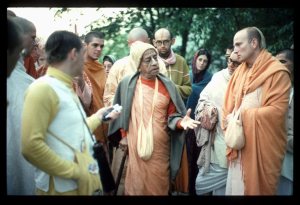(Kadamba Kanana Swami, 2009, Bhaktivedanta Manor, England, Lecture)

At the end of our life, our own service will be judged but more important, is the service of our spiritual master, who is requesting Krsna,
“Please accept him, he didn’t do well but accept him anyway.”This is actually how it works. Thus Srila Prabhupada is praying for all of us and saying, “Please take them all back to Godhead. I know everything but still… Please take them back to Godhead.”
Then what can Krsna do, because Prabhupada has done such service that Krsna has become so indebted; what can he do!? So when Srila Prabhupada is asking then, “All right, let him go.”
So mercy is a major factor and thus we must look for that mercy. Therefore, we must always turn to our spiritual master. It’s not that the spiritual master should turn to us, we should turn to him for shelter!

 Amazing quality video! It is just as if you were present on the temple! You may have to use the quality settings button on the player below and choose the 2160p option. It takes time for slower connections. Read more ›
Amazing quality video! It is just as if you were present on the temple! You may have to use the quality settings button on the player below and choose the 2160p option. It takes time for slower connections. Read more ›  Amazing quality video! It is just as if you were present on the temple! You may have to use the quality settings button on the player below and choose the 2160p option. It takes time for slower connections. Read more ›
Amazing quality video! It is just as if you were present on the temple! You may have to use the quality settings button on the player below and choose the 2160p option. It takes time for slower connections. Read more ›  Householders and vanaprasthas should bathe two times a day. A sannyasi should bathe three times a day, and a brahmacari may take only one bath a day. Whenever one is not able to bathe in water, he can bathe by chanting the Hare Krishna mantra. (Sri Caitanya-caritamrta, Madhya-lila, 24.331 Purport)
Householders and vanaprasthas should bathe two times a day. A sannyasi should bathe three times a day, and a brahmacari may take only one bath a day. Whenever one is not able to bathe in water, he can bathe by chanting the Hare Krishna mantra. (Sri Caitanya-caritamrta, Madhya-lila, 24.331 Purport)  One may live in a cave, in a cottage beside a river, in a palace or in a big city like New York or London. In any case, a devotee can follow the instructions of his spiritual master and engage in devotional service by watering the tulasi plant and chanting the Hare Krishna mantra. (Sri Caitanya-caritamrta, Madhya-lila, 24.261)
One may live in a cave, in a cottage beside a river, in a palace or in a big city like New York or London. In any case, a devotee can follow the instructions of his spiritual master and engage in devotional service by watering the tulasi plant and chanting the Hare Krishna mantra. (Sri Caitanya-caritamrta, Madhya-lila, 24.261)  In any condition, a man can live in a small cottage, plant a tulasi tree, water it in the morning, offer it prayers, and continuously chant the Hare Krishna maha-mantra. Thus one can make vigorous spiritual advancement. This is not at all difficult. (Sri Caitanya-caritamrta, Madhya-lila, 24.261)
In any condition, a man can live in a small cottage, plant a tulasi tree, water it in the morning, offer it prayers, and continuously chant the Hare Krishna maha-mantra. Thus one can make vigorous spiritual advancement. This is not at all difficult. (Sri Caitanya-caritamrta, Madhya-lila, 24.261) 







 'Yamuna Devi - The Life of Unalloyed Devotion' book Launch in Vrindavan (25-Oct-2014)
'Yamuna Devi - The Life of Unalloyed Devotion' book Launch in Vrindavan (25-Oct-2014)  It is not that one must chant at a certain time. No. At any time one may chant. Furthermore, Krishna's name is identical with Krishna Himself. Therefore the holy name of Krishna is Krishna. (Teachings of Queen Kunti, 8, Purport).
It is not that one must chant at a certain time. No. At any time one may chant. Furthermore, Krishna's name is identical with Krishna Himself. Therefore the holy name of Krishna is Krishna. (Teachings of Queen Kunti, 8, Purport).  One who is interested in chanting the holy name of Krishna or who by practice likes to chant Krishna's names should be accepted as a Vaisnava and offered respects as such, at least within one's mind. (Sri Caitanya-caritamrta, Madhya-lila, 15, 111)
One who is interested in chanting the holy name of Krishna or who by practice likes to chant Krishna's names should be accepted as a Vaisnava and offered respects as such, at least within one's mind. (Sri Caitanya-caritamrta, Madhya-lila, 15, 111)  If one hears a person say even once the word "Krishna" that person should be accepted as the best man out of the common group. (Sri Caitanya-caritamrta, Madhya-lila, 15, 106)
If one hears a person say even once the word "Krishna" that person should be accepted as the best man out of the common group. (Sri Caitanya-caritamrta, Madhya-lila, 15, 106)  By chanting Hare Krishna one fixes his mind always on the Supreme Lord. One example often given is that of the caterpillar that thinks of becoming a butterfly and so is transformed into a butterfly in the same life. Similarly, if we constantly think of Krishna, it is certain that at the end of our lives we shall have the same bodily constitution as Krishna.
(Bhagavad-gita, 8.8 Purport)
By chanting Hare Krishna one fixes his mind always on the Supreme Lord. One example often given is that of the caterpillar that thinks of becoming a butterfly and so is transformed into a butterfly in the same life. Similarly, if we constantly think of Krishna, it is certain that at the end of our lives we shall have the same bodily constitution as Krishna.
(Bhagavad-gita, 8.8 Purport) 